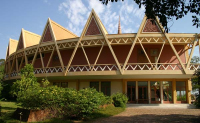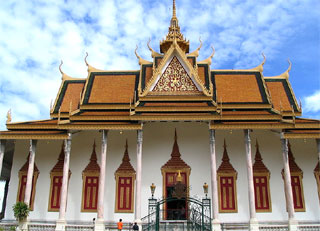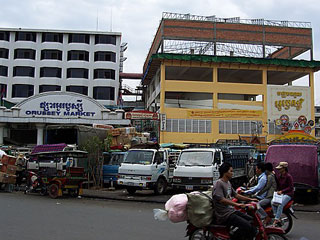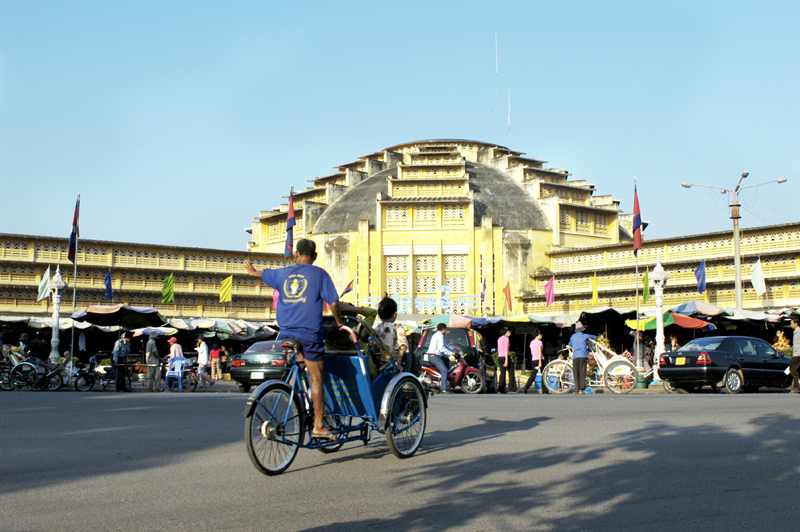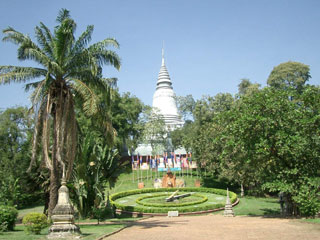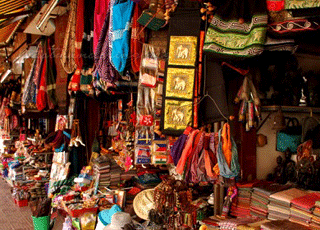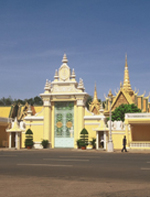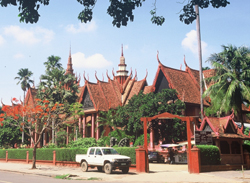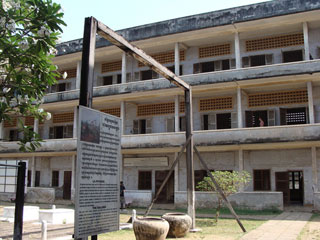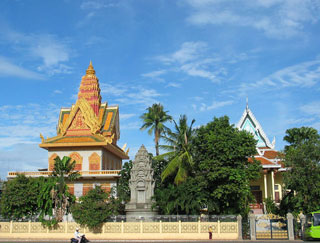Things to See and Do - Phnom Penh, Cambodia
Independence Monument - Phnom Penh
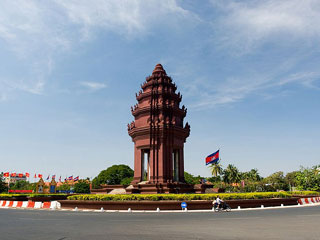
An Angkorian style tower, the inimitable place in the whole city, located in the heart of the capital. It was built in 1958 to Sybilles Cambodian Independence Day after winning back their independence from the French protectorate on the 9th of November 1953. The monument attracts many tourists for its peculiar looking but unique style distinguishes it from all the buildings in the city. It is also used as a memorial place dedicated to the Cambodian's patriot who died for the country.
The Independence Monument (Vimean Ekareach) was inaugurated on November 9, 1962 to celebrate the independence from the French in 1953, but now also serving as a cenotaph to Cambodia?s war dead. The 20-meter high monument was designed by Cambodian architect, Vann Molyvann, and is shaped in the form of a lotus, which also can be seen at Angkor and other Khmer historical sites. You are not allowed to enter the monument. At night it is lit with blue, red and white light (the colours of the national flag) and it should be an impressive sight - but I didn?t see it.
There is a big open park at the Independence Monument and it seems to be a popular place among the locals. Smacked right at the corner of Norodom and Sihanouk Blvd, this piece of landmark is hard to miss. I took a nice picture of this piece but be careful because it is located in the middle of a roundabout.The monument was built in 1962 to celebrate Cambodia's independence from the foreign rule. It also serves as a monument to Cambodias war dead. It is the site for celebrations and services.When walking around in the city of Phnom Penh, have a look on the Independence Monument,10 minutes walking behind the Royal Palace.
It is surrounded by very large parcs and fountains and the monument itself is not the most impressive in the city. The Independence Monument in Phnom Penh, capital of Cambodia, was built in 1958 following the country's independence from France. It stands on the intersection of Norodom and Sihanouk Boulevards in the centre of the city. It is in the form of a lotus-shaped stupa, of the style seen at the great Khmer temple at Angkor Wat and other Khmer historical sites.The Independence Monument was inaugurated in 1958 to celebrate Cambodia's independence from foreign rule, now it also serves as a monument to Cambodia's war dead. At night the monument is illuminated by red, blue and white floodlights, the colors of the Cambodian flag. It is the site of celebrations and services on holidays such as Independence Day and Constitution Day.
At night in Independence Monument
Credit VornLimHourVLHpp PhnomPenhCity-LiveShow
History of Independence Monument
Map of Independence Monument
Other Attractions in Phnom Penh
Chaktomuk Conference Hall
The Chaktomuk Conference Hall is located at Preah Sisowath Quay, Sangkat Chaktomuk, Khan Daun Penh. It designed by renowned architect Vann Molyvann, this venue was originally opened in 1961 as La Salle de Conf?rence Chaktomuk. Earmarked for redevelopment as a restaurant in 1991, it was brought back into use as a theatre in 1994... read more
Cheung Ek Killing Field
Between 1975 and 1978,aabout 17,000 men, women, children and infants (including nine westerners), detained and tortured at S-21 prison (now Tuol Sleng Museum), were transported to the extermination to death to avoid wasting precious bullets.The remains of 8985 people, many of whom were bound and blindfolded, were exhumed in 1980... read more
Chroy Changvar Bridge
Cambodia-Japan Friendship Bridge - It was constructed in 1966. During the war from 1973 to 1975 the Khmer Rouge forces mined twice to death in 1973. By 17th April 1975, all Phnom Penh citizens have been chased out of the city, by Khmer Rouge forces, to live and farm at the rural areas. Therefore, the bridge has been abandoned... read more
Silver Pagoda
Wat Preah Keo Morakot (Silver Pagoda) is located in the southern portion of the Royal Palace complex. The pagoda was formerly known as Wat Uborsoth Rotannaram because it is where the King worshiped, prayed and practiced every Buddhist Silas Day. In the additional, the royal family and officials also held Buddhist ceremonies... read more
Orussey Market
Orussey Market is Centrally located, Orussey Market is much more geared towards locals than tourists; hence you will not find as much in the way of souvenirs as the other markets mentioned. A huge array of foodstuffs is on offer including the wet market with fresh meat, poultry and seafood. Other items in abundance include house... read more
Central Market (Phsar Thmei)
The dark-yellow Art Deco Phsa Thmei (New Market) is also referred to as the Central Market, a reference to its location and size. It was constructed in 1935 37. The Art deco building is shaped in the form of a cross with a nice central dome. And has four wings filled with shops selling gold and silver jewelry, antique coins, fake... read more
Wat Phnom Hill
Set on top of a tree-covered knoll 27m high, Wat Phnom is the only hill in town. According to legend, the first pagoda on this site was erected in 1373 to house four statues of Buddha deposited here by the waters of the Mekong and discovered by a woman name, Penh. The main entrance to Wat Phnom is via the grand eastern staircase,... read more
Old Market ( Phsar Chas)
Old Market (Phsar Chas) is a local market that is not at all geared to the tourist. It carries such items as fruits and vegetable, second hand cloths, hardware, motorcycle parts and religious items. In the late afternoon food vendors and fruit sellers set up mats along Street 13 in preparation for the evening market. The dinner rush... read more
Royal Palace
Gleaming in gold, the Royal Palace is one of Phnom Penh?s most splendid architectural achievements. It is home to His Majesty Preah Bat smdech Preah Norodom Sihanouk and Her Majesty Preah Reach Akka-Mohesey Norodom Monineath. The palace was built in 1866 by His Majeaty Preah Bat Norodom, great grandfather to our current King. The... read more
Riverfront Park
A stroll or Cyclo ride along the park-lined riverfront is a must pubs, restaurants, shops and tourist boats line the way. Chhrouy Changva park is another newly attraction at the other side of the river opposite the Royal Palace. The view of the confluence of Mekong and the Tonle Sap is geographically unique. Early risers, check out... read more
National Museum
The NATIONAL MUSEUM has a good collection of Khmer sculptures dating from the pre-Angkor period (4th century) to post-Ankgor period (14th century). The museum, built of red bricks by the French in 1917 in a pseudo-Khmer style, is built around a courtyard.A stone's throw away from the Tonle Sap is the royal Palace built on the site... read more
Independence Monument
An Angkorian style tower, the inimitable place in the whole city, located in the heart of the capital. It was built in 1958 to Sybilles Cambodian Independence Day after winning back their independence from the French protectorate on the 9th of November 1953. The monument attracts many tourists for its peculiar looking but unique... read more
Tuol Tompoung Market
So-named because of the prevalence of items from the Eastern Bloc in past times, the Toul Tom Poung Market today is a treasure trove for tourists. Particular items worth seeking out include CDs, fabrics, jewelry, carved handicrafts and ceramics. There are also a large number of clothing outlets and on site tailors and seamstresses... read more
Toul Sleng Genocidal Museum (S-21)
In 1975, Tuol Svay Prey High School was taken over by Pol Pot's security force and turned into a prison known as Security Prison 21 (S-21). It soon became the largest such center of detention and torture in the country. Over 17,000 people held at S-21 were taken to the extermination camp at Choeung Ek to be executed; detainees who... read more
Ounalom Pagoda
Wat Ounalom is another of Phnom Penh's five original monasteries (1422). it housed the Institute Bouddhique and library. On the riverfront about 250 meters north of the National Museum, facing the Tonle Sap River near the Royal Palace, this pagoda serves as the headquarters for one of Cambodia?s most revered Buddhist... read more



